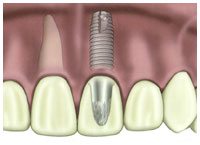Dental implants are a reliable and long-lasting replacement for missing teeth.
A dental implant consists of two parts. First there is a root form that is placed in the jaw. It is approximately the same size as a tooth root, and it takes the place of the root of the missing tooth.
 Usually a healing period is required for the process known as osseointegration—during which the bone grows in tightly around the root form so that it is solidly anchored. By tightly adapting the surgical site to the root form, this healing period can be shortened. Some practitioners offer what is called “teeth in an hour,” where the dental implant is placed into function immediately. This can be done, but there may be a trade-off between risk and patience here. When the healing time is rushed, there could be increased risk of failure.
Usually a healing period is required for the process known as osseointegration—during which the bone grows in tightly around the root form so that it is solidly anchored. By tightly adapting the surgical site to the root form, this healing period can be shortened. Some practitioners offer what is called “teeth in an hour,” where the dental implant is placed into function immediately. This can be done, but there may be a trade-off between risk and patience here. When the healing time is rushed, there could be increased risk of failure.
The visible part of the dental implant is the crown. An abutment is screwed into the root form and the crown is placed over it.
If the process is done well, the end result is very functional, long-lasting, and highly esthetic.
Situations Where Dental Implants Are Used
- If you are missing all your teeth, dental implants are far preferable to removable complete dentures. Removable dentures not only have poor chewing efficiency (less than 50% of normal chewing efficiency), but they will lead to gradual bone resorption ending up with facial collapse and the inability to reasonably fit any kind of a denture.
- If you have one or two teeth missing, and the adjacent teeth are intact and healthy, dental implants are a good idea. They eliminate the need for placing crowns on adjacent healthy teeth.
- If your missing tooth or teeth are in the very back of your mouth, you may not have the option of having potential supporting teeth on both sides. In this case, the only solutions would be dental implants or a uncomfortable removable appliance. The same is true if you have a number of missing teeth.

A diagram showing the root form and a crown placed over the root form. In an actual case, the root form is embedded in the bone and not visible. (see actual clinical photograph below).
Advantages and Disadvantages of a Dental Implant
As compared to a dental bridge, for replacing a single tooth
Disadvantages:
- There is usually a healing time required.
- They may be more expensive than other methods of tooth replacement.
Advantages:
- It isn’t required to prepare the adjacent teeth. The old-fashioned method for replacing a missing tooth is with a dental bridge. A dental bridge requires preparing the adjacent teeth for crowns, and then the false tooth is suspended between those two crowns. It’s nice to avoid this aggressive treatment of otherwise healthy teeth.
- Maintenance is less expensive. If a dental bridge has any trouble with any one of the three or more teeth involved, the entire restoration usually has to be replaced. Additionally, cleaning it properly requires the use of floss threaders, which most people find troublesome. A dental implant, however, can be brushed and flossed normally, and in the unlikely event that there is trouble with it later, no other teeth need to be involved in the treatment of the problem.
- They preserve the bone. When a tooth is extracted, the body senses the loss and begins to resorb the bone that used to support that tooth. In the case of multiple missing teeth, this can lead to facial collapse, inability to wear even removable teeth, or jaw fracture. This is in addition to the esthetic problems. The presence of a dental implant signals to the body that this bone is still needed, and these difficulties are prevented.
For patients with no natural teeth left, dental implants are really the only treatment that will yield a satisfactory result.
This content was written by Dr. David Hall
